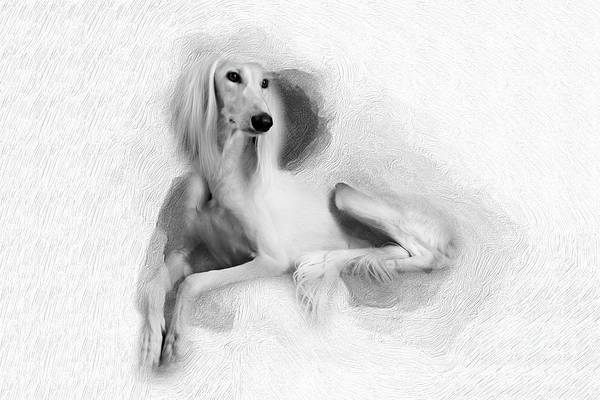
For adherents of various Eastern religions, particularly Mohammedanism, there is a blessing that is regarded as a spiritual force and divine gift that exists in saints, charismatic leaders, and natural objects as chosen by God. It is a continuity of a spiritual presence and revelation that begins with God, its sole source, and flows through the things and beings closest to God. This mysterious but gentle power is known as Baraka.
Creations endowed with baraka can then transmit the flow of baraka to the other creations of God through physical proximity, or through adhering to the spiritual practices of the Islamic prophet, Muhammad. Among the things that Baraka envelops are camels, brides-to-be, mountains, and the Saluki.
The Saluki’s telescopic vision is the gift of Allah, as is his swiftness. Both are said to have baraka. He can outrun one of the fastest creatures on earth, an Arabian gazelle, because he is driven by the force of baraka. The gazelle will disagree, but metaphorically, to be eaten by one so holy as a blessed Saluki is to be reborn, to enter the force of baraka, to be one with Allah.
Some believe that the Saluki is an emissary between the world of life and death. It is for this reason that it was taboo to sell a Saluki, and that it is one of the only animals allowed to enter heaven.
Image: “White Saluki by Mia Stedt is available as fine art and in home decor and lifestyle items here

The dog as a messenger or guide is found in a number of ancient cultures. From the Americas https://scholarworks.wm.edu/cgi/viewcontent.cgi?article=1257&context=honorstheses , to the Celts http://branawen.blogspot.com/2011/07/celtic-symbolism-celtic-hounds.html#:~:text=Celtic%20Hounds%20symbolize%20hunting%2C%20healing,ritual%20to%20gain%20prophetic%20vision., Greeks (Cerberus) and including ancient Egypt. . See also https://www.sciencedirect.com/science/article/abs/pii/S0305440318300049 for a find documenting the human/dog bond being of long standing. — The Bonn-Oberkassel dog was a late juvenile when it was buried at approximately age 27–28 weeks, with two adult humans and grave goods. The Bonn-Oberkassel dog remains (Upper Pleistocene and 14223 +- 58 years old)
Great info, Peggy, thanks!!